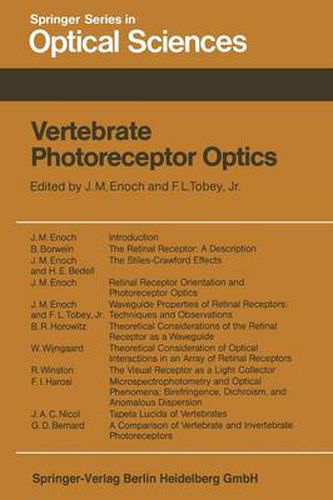Readings Newsletter
Become a Readings Member to make your shopping experience even easier.
Sign in or sign up for free!
You’re not far away from qualifying for FREE standard shipping within Australia
You’ve qualified for FREE standard shipping within Australia
The cart is loading…






This title is printed to order. This book may have been self-published. If so, we cannot guarantee the quality of the content. In the main most books will have gone through the editing process however some may not. We therefore suggest that you be aware of this before ordering this book. If in doubt check either the author or publisher’s details as we are unable to accept any returns unless they are faulty. Please contact us if you have any questions.
It is in the receptors of the vertebrate retina that the characteristic visual process - the transduction of radiational energy into physiological activtty of a different kind - takes place. The way these receptors modify or redistribute the incident radiation and thereby control the light ab sorption by the visual pigments they contain, is the central theme of this book. As far back as 1843 Brucke put forward a well-reasoned model for the optics of a receptor, assuming simple ray optics, and it is already some forty-seven years since the dependence of receptor sensitivity on retinal angle of incidence was established experimentally as an important factor in human vision and as one by which the direction of alignment of receptors in the living eye might be determined. But it is to Professor J. M. Enoch, editor and author of several major contributions to this volume, that we owe the first experimental demonstration (in 1961) of the wave-mode propa gation of light in vertebrate visual receptors, as well as the results of some thirty years devoted research concerned with all questions of receptor optics, particularly directional sensitivity and receptor alignment, both for normal vertebrate eyes and for pathologically modified eyes. His work on the latter has opened up a whole range of clinical possibilities.
$9.00 standard shipping within Australia
FREE standard shipping within Australia for orders over $100.00
Express & International shipping calculated at checkout
This title is printed to order. This book may have been self-published. If so, we cannot guarantee the quality of the content. In the main most books will have gone through the editing process however some may not. We therefore suggest that you be aware of this before ordering this book. If in doubt check either the author or publisher’s details as we are unable to accept any returns unless they are faulty. Please contact us if you have any questions.
It is in the receptors of the vertebrate retina that the characteristic visual process - the transduction of radiational energy into physiological activtty of a different kind - takes place. The way these receptors modify or redistribute the incident radiation and thereby control the light ab sorption by the visual pigments they contain, is the central theme of this book. As far back as 1843 Brucke put forward a well-reasoned model for the optics of a receptor, assuming simple ray optics, and it is already some forty-seven years since the dependence of receptor sensitivity on retinal angle of incidence was established experimentally as an important factor in human vision and as one by which the direction of alignment of receptors in the living eye might be determined. But it is to Professor J. M. Enoch, editor and author of several major contributions to this volume, that we owe the first experimental demonstration (in 1961) of the wave-mode propa gation of light in vertebrate visual receptors, as well as the results of some thirty years devoted research concerned with all questions of receptor optics, particularly directional sensitivity and receptor alignment, both for normal vertebrate eyes and for pathologically modified eyes. His work on the latter has opened up a whole range of clinical possibilities.